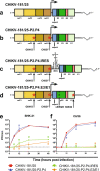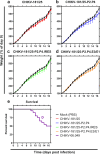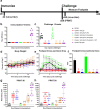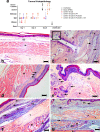Engineering a fidelity-variant live-attenuated vaccine for chikungunya virus
- PMID: 33083032
- PMCID: PMC7560698
- DOI: 10.1038/s41541-020-00241-z
Engineering a fidelity-variant live-attenuated vaccine for chikungunya virus
Abstract
Chikungunya virus (CHIKV), which causes a febrile illness characterized by severe and prolonged polyarthralgia/polyarthritis, is responsible for a global disease burden of millions of cases each year with autochthonous transmission in over 100 countries and territories worldwide. There is currently no approved treatment or vaccine for CHIKV. One live-attenuated vaccine (LAV) developed by the United States Army progressed to Phase II human clinical trials but was withdrawn when 8% of volunteers developed joint pain associated with vaccination. Attenuation of the Army's CHIKV LAV strain 181 clone 25 (CHIKV-181/25) relies on two mutations in the envelope 2 (E2) glycoprotein responsible for cell binding and entry, making it particularly prone to reversion, a common concern for replication-competent vaccines. High error rates associated with RNA virus replication have posed a challenge for LAV development where stable incorporation of attenuating elements is necessary for establishing safety in pre-clinical models. Herein, we incorporate two replicase mutations into CHIKV-181/25 which modulate CHIKV replication fidelity combined with additional attenuating features that cannot be eliminated by point mutation. The mutations were stably incorporated in the LAV and did not increase virulence in mice. Two fidelity-variant CHIKV LAVs generated neutralizing antibodies and were protective from CHIKV disease in adult mice. Unexpectedly, our fidelity-variant candidates were more mutable than CHIKV-181/25 and exhibited restricted replication in mice and Aedes mosquitoes, a possible consequence of hypermutation. Our data demonstrate safety and efficacy but highlight a further need to evaluate fidelity-altering phenotypes before use as a LAV given the potential for virulent reversion.
Keywords: Alphaviruses; Live attenuated vaccines; Viral infection.
© The Author(s) 2020.
Conflict of interest statement
Competing interestsThe authors declare no competing interests.
Figures







Similar articles
-
Chikungunya Virus Fidelity Variants Exhibit Differential Attenuation and Population Diversity in Cell Culture and Adult Mice.J Virol. 2019 Jan 17;93(3):e01606-18. doi: 10.1128/JVI.01606-18. Print 2019 Feb 1. J Virol. 2019. PMID: 30429348 Free PMC article.
-
Deliberate attenuation of chikungunya virus by adaptation to heparan sulfate-dependent infectivity: a model for rational arboviral vaccine design.PLoS Negl Trop Dis. 2014 Feb 20;8(2):e2719. doi: 10.1371/journal.pntd.0002719. eCollection 2014 Feb. PLoS Negl Trop Dis. 2014. PMID: 24587470 Free PMC article.
-
Chikungunya viruses that escape monoclonal antibody therapy are clinically attenuated, stable, and not purified in mosquitoes.J Virol. 2014 Aug;88(15):8213-26. doi: 10.1128/JVI.01032-14. Epub 2014 May 14. J Virol. 2014. PMID: 24829346 Free PMC article.
-
Nonhuman Primate Models of Chikungunya Virus Infection and Disease (CHIKV NHP Model).Pathogens. 2015 Sep 16;4(3):662-81. doi: 10.3390/pathogens4030662. Pathogens. 2015. PMID: 26389957 Free PMC article. Review.
-
Chikungunya virus: epidemiology, replication, disease mechanisms, and prospective intervention strategies.J Clin Invest. 2017 Mar 1;127(3):737-749. doi: 10.1172/JCI84417. Epub 2017 Mar 1. J Clin Invest. 2017. PMID: 28248203 Free PMC article. Review.
Cited by
-
Novel approaches for the rapid development of rationally designed arbovirus vaccines.One Health. 2023 May 13;16:100565. doi: 10.1016/j.onehlt.2023.100565. eCollection 2023 Jun. One Health. 2023. PMID: 37363258 Free PMC article.
-
Alphavirus Virulence Determinants.Pathogens. 2021 Aug 3;10(8):981. doi: 10.3390/pathogens10080981. Pathogens. 2021. PMID: 34451445 Free PMC article. Review.
-
A safe insect-based chikungunya fever vaccine affords rapid and durable protection in cynomolgus macaques.NPJ Vaccines. 2024 Dec 19;9(1):251. doi: 10.1038/s41541-024-01047-z. NPJ Vaccines. 2024. PMID: 39702442 Free PMC article.
-
Optimized production and immunogenicity of an insect virus-based chikungunya virus candidate vaccine in cell culture and animal models.Emerg Microbes Infect. 2021 Dec;10(1):305-316. doi: 10.1080/22221751.2021.1886598. Emerg Microbes Infect. 2021. PMID: 33539255 Free PMC article.
-
Distinct chikungunya virus polymerase palm subdomains contribute to virus replication and virion assembly.bioRxiv [Preprint]. 2024 Jan 15:2024.01.15.575630. doi: 10.1101/2024.01.15.575630. bioRxiv. 2024. Update in: PLoS Pathog. 2024 Oct 14;20(10):e1011972. doi: 10.1371/journal.ppat.1011972. PMID: 38293111 Free PMC article. Updated. Preprint.
References
Grants and funding
LinkOut - more resources
Full Text Sources
Other Literature Sources

